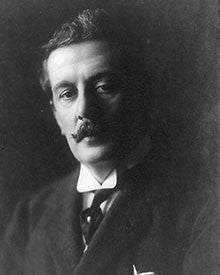
(1858 - 1924)
Giacomo Puccini was a native of Lucca, born into a family which since the arrival there of a Giacomo Puccini in the 1730s had been involved in the music of the ancient town for five generations. Each generation composed and played the organ for San Martino Cathedral in Lucca. Giacomo was the fifth child of Michele and Albina Puccini. Giacomo showed no early interest in music, although everyone in Lucca expected him to. Instead he was lazy, poor at schoolwork and apt to play truant. His mother, however, was convinced of his abilities and procured him a tutor at the Conservatorio Musici. This time he made modest progress, becoming a choirboy at San Martino and playing the organ there from the age of 14. By his seventeenth year he had begun writing small compositions. While still 17, Puccini attended a performance of Giuseppe Verdi's Aïda in Milan; it was this experience which concentrated all his ambitions, convincing him that a career as an opera composer was the only one to consider. For the next four years he studied hard, eventually writing a pleasing Mass in 1860 (later called Messa di Gloria).
Giacomo Puccini Composition Timpani and Percussion Requirements
Gianni Schicchi
Timpani + 2 percussion
1) ruhrtrommel, triangle, stage - low F# bell, 2) orchestral bass drum, suspended cymbal
__________________________________________________________________________________
La Boheme
Timpani
Int'l 32/29/26/23 Prem 32/30/28/25
4 percussion
Snare drum, triangle, clash cymbals, bass drum, xylophone, glockenspiel, tubular bells
__________________________________________________________________________________
La Fanciulla del West
Timpani + 4 percussion + 1 off stage
1) glockenspiel, orchestral bass drum, suspended cymbal, 2nd timpani
2) suspended cymbal, clash cymbals
3) snare drum, tubular bells D F A, tam tam
4) triangle
5) wind machine off stage
__________________________________________________________________________________
La Rondine
Timpani + 5 percussion
1) snare drum, vibraphone, off stage tubular bells with low Ab & Bb, 2) glockenspiel, 3) triangle, 4) clash cymbals, 5) orchestral bass drum
__________________________________________________________________________________
Madame Butterfly - Complete Opera
Timpani
Int'l 32/29/26/23 Prem 32/30/28/25
5 percussion + 1 offstage
1) glockenspiel, 2) tuned gongs, 3) snaare drum, clash cymbals, suspended cymbal, 4) orchestral bass drum, (part clash cymbals), 5) triangle, tam tam, 6) off stage, tam tam, cannon, 3 tubular bells, A B Db Eb. Other stage effects done by singers / music staff
Gongs: Act 1
Top row F, G, D, F#, G#
Lower row A2, Bb, C, E
Gongs Act 3
Top row F, G, Db, Eb, G#
Lower row A, B, C, E
12 pitches in total
A2, Bb, B, C, Db, D, Eb, E, F, F#, G, G#
__________________________________________________________________________________
Tosca
Timpani
Int'l 32/29/26/23 Prem 32/30/28/25
3 percussion
Clash cymbals, orchestral bass drum, triangle, glockenspiel, tam tam, tubular bells & 3 low bass bells, snare drum
__________________________________________________________________________________
Turandot
Timpani + 8 percussion
1) tuned gongs A2, A#, C3, C#, D, D#, E, F, F#, G, G#, A, off stage wood block (act 2), off stage marimba
2) xylophone, tam tam, marimba, tubular bells
3) snare drum, muffled drum, tubular bells, off stage tam tam
4) marimba, wood block, off stage gong, suspended cymbal, glockenspiel
5) orchestral bass drum, suspended cymbal
6) clash cymbals, suspended cymbal
7) triangle, tam tam
8) keyboard glockenspiel
__________________________________________________________________________________
